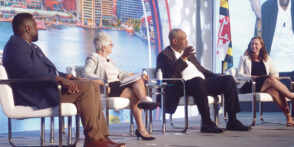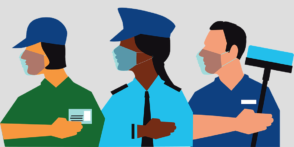Connecting With Safety Stakeholders
Success depends on effective collaboration
 This time a year ago, I used my MOVE column to reflect on the absence of in-person AAMVA gatherings—how much we missed them; how eager we were to resume them. Fast forward a year and I am happily reflecting on recent encounters at in-person events of AAMVA stakeholders and members.
This time a year ago, I used my MOVE column to reflect on the absence of in-person AAMVA gatherings—how much we missed them; how eager we were to resume them. Fast forward a year and I am happily reflecting on recent encounters at in-person events of AAMVA stakeholders and members.
The in-person “vibe” and unintentional conversations I experienced in these past few months reinforce just how much we miss when computer screens and telephones are our main forms of engaging. I am reminded that chance meetings face-to-face fill gaps in our knowledge, relationships, work and gaps we may not recognize until the unscripted conversation occurs.
After two years of limited in-person meetings, we have become good at carrying out business over virtual connections. But we also need the unexpected connection during in-person engagements and I am very glad to know many of you plan to travel to AAMVA meetings and events this year to reconnect in substantive sessions and through unscripted encounters.
Connections matter, and this issue of MOVE magazine shines a spotlight on stakeholders within the AAMVA community who deploy strategies, programs and advocacy to reduce the risk of serious and fatal crashes. The Road to Zero (RTZ) coalition, managed by the National Safety Council, highlights these partnerships in its roadmap to get to zero traffic deaths.
The roadmap is as clear today as it was when the coalition released it last year. It is a call to action and the U.S. Department of Transportation responded with the recently issued National Roadway Safety Strategy (NRSS). While laying out multiple strategies to improve transportation safety nationwide, the NRSS calls on all stakeholders as essential to fulfilling its promise. The AAMVA community models stakeholder collaboration and together forms a community of practitioners essential to success.
The NRSS calls out excessive speed, impairment and not wearing seatbelts for our immediate focus. The three high-risk behaviors represent the leading contributors to serious and fatal crashes and strategies like alcohol ignition interlock devices, administrative license suspensions to deter impaired driving, enforcement of primary seat belt laws, support for high visibility law enforcement, graduated driver’s license requirements for novice drivers, and traffic enforcement strategies focused on dangerous driving behaviors are all interventions that work. These are strategies the AAMVA community heavily influences, and their success depends on effective stakeholder collaboration.
Further in the report, the NRSS calls on states and federal agencies to strengthen systems for the electronic exchange of non-CDL driver history record information, much like the community is doing through the exclusively electronic exchange of CDLIS records and the driver history record exchange capability in the State-to-State Verification Service. With timely, accurate records, our traffic enforcement and court partners can better identify and take unsafe drivers off the road.
In other words, stakeholder collaboration on these many strategies, along with the other actions NRSS and RTZ outline in the reports above, are key to reaching zero fatalities. AAMVA is committed to supporting our community in this work, and we are excited to intensify our connection through in-person meetings in the months and years ahead.
– Anne Ferro
AAMVA President and CEO




